To Merchant Navy
To WW2 Sea Index
|
To Merchant Navy |
|
To WW2 Sea Index |

3rd September 1939
Includes a survivors exclusive copyright account of this event
Hilter's War against children - see
also
Benares
2018 New:
Youtube - video of survivors
|
The German U Boat U-30 had been at sea for several days, under strict orders to avoid contact or discovery. On September 3rd 1939 she received notification that Germany was now at war with Great Britain. The U boat’s commander was Lieutenant Fritz-Julius Lemp. He had been in command for almost a year, therefore was not unaware of the “rules”. According to Admiral Doenitz at his trial at Nurenberg, Lemp had been under orders, when notified of the outbreak of hostilities, to keep a lookout for Armed Merchant Cruisers. Doenitz is not specific as to why this should be a priority at the outbreak of war. Germany had invaded Poland on 1st September 1939 and on 3rd September 1939, at 1115 hrs, Britain declared war on Germany. |
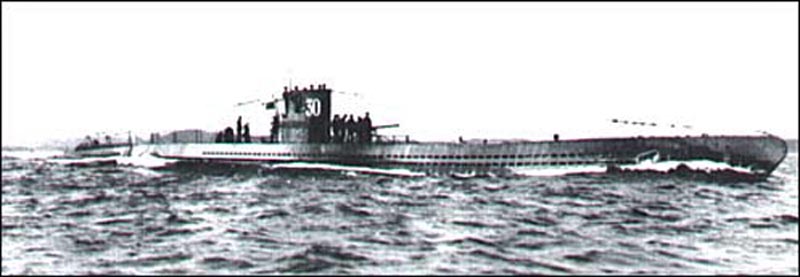 U 30 |
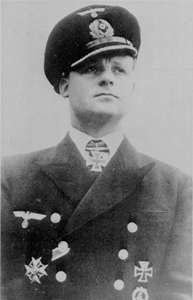 Lemp - Commander of U Boat U-30 |
The Donaldson Liner Athenia, on charter to Cunard, had already left Glasgow on the 1st September and was heading for Montreal with 1100 passengers, more than 300 of which were American. Many were women and children. On the evening of September 3rd, she was sighted by the U-30 about 250 miles northwest of Inishtrahull, Northern Ireland. She was running without lights. Before sailing all German U boats had been issued with strict orders to operate within the Prize Rules, international laws governing the conduct of war at sea. This was known as the Hague convention. Merchant ships were to be stopped and searched, if they were found to be carrying enemy cargo, they could be sunk. This was only after the crew had been seen safely into lifeboats. U-30 had received this signal. Upon sighting the ship, Lemp decided there and then that she was an Armed Merchant Cruiser and shadowed her, watching her zig-zig pattern and course and speed. |
|
Lemp attacked the
Athenia without warning. He fired two torpedoes, one of which exploded
amidships, ripping open the bulkhead between the engine room and the boiler
room. As soon as he had fired the two torpedoes he dived if a torpedo should
come back on him. One did misfire. As he came back up to the surface he saw the
Athenia starting to list and fired a third torpedo. This too missed. (see email below from John Hewitt,
author, about this part, below.) There is an email below stating that the senders father, a seaman aboard, reported that the U Boat raked the ship with gunfire. |
The explosion, it is stated, blew a large volume of water into the air and destroyed the bulkhead. It also shattered an oil tank and destroyed the access stairs to the upper decks from the third-class and the tourist dining saloons. “It was impossible for passengers trapped in the dining-room to escape and they were drowned below decks,” the report adds. A separate report from Mr John Cudahy, the American Minister to Ireland, says that witnesses stated that the ship was struck amidships, and was shortly afterwards struck again “by a projectile projected through the air.” Witnesses stated that “the second explosion hit with terrific force” and immediately after this they saw a line of black smoke from the surface of the water 800 to 1,000 yards on the port side to where the ship was hit. Mr Cudahy’s report added: “I cannot praise too highly the efficient handling of the situation by Galway and the Irish Government and their splendid human spirit.” Daily Telegraph (link at base of page). |
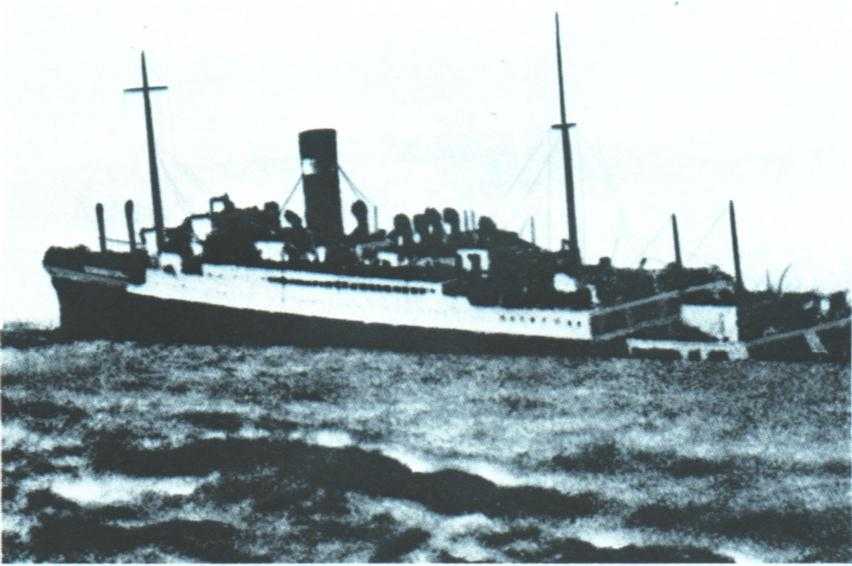 The Athenia begins to go down |
Perhaps this torpedo being fired caused some of the survivors, in their panic, to imagine that they had been “fired upon”, as this was stated at the enquiry. Lemp was by now close enough to see her silhouette. Something troubled him, as the radio operator, Hogel, later recalled that he had heard the distress call. “I realized it could not be a troop transport but had passengers on board. I knew her name from the call sign – Athenia. Then the commander came to the radio room and asked for the Lloyds Register which listed all sea vessels and the various types. His fingers came to rest on the Athenia. He was, of course, shocked”. |
| An apparent clear insight into what had gone through Lemps mind and his reaction. Soon afterwards the U-30 intercepted a plain language transmission from the ship identifying itself as the Athenia. Now that the Athenia had been transmitting, there was little need for Lemp to conceal his location, but he failed to radio back to base with his report, instead choosing to remain silent. Lemp knew full well the enormity of his blunder and of the consequences to Germany. I now have evidence that he also fired with his deck gun on the Athenia - see email June 08 below. | The ship sank with the loss of 112 passengers and crew. However, despite the fact that Lemp had murdered 28 US citizens, within hours Roosevelt had announced that his Government was preparing “a declaration of American neutrality”. |
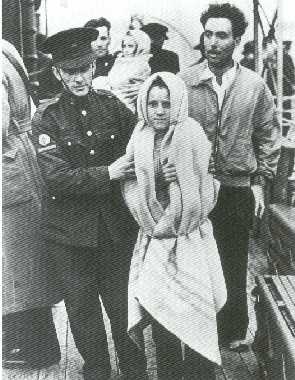 |
 Survivors (left) and how Punch Magazine saw the attack |
|
Lemp remained silent for 11 more days, finally calling in on September 14th. But still he failed to mention the Athenia, instead he reported damage received in a confrontation with 2 destroyers after he had sunk the freighter Fanad Head, and to request permission to offload a wounded man in Iceland for urgent medical attention. Lemp did not give any assistance to the survivors either, also contrary to the rules of engagement. Also, a few days layer, when he sank the Blairlogie, he did nothing there for survivors. (See Note 1 right) It is possible that he knew of the existence of the Norwegian freighter Knut Nelson in the vicinity and assumed they would come to the stricken ships aid. Going on his track record to date, I somehow do not think so. It is more likely that he just wanted to flee the scene as quickly as possible. It was a horrendous mistake. Lemp had not taken time to correctly identify the target. He had only a couple of hours before been informed by U Boat Command that he was now on a war footing instead of a peacetime patrol, it is entirely possible that he panicked. |
 (1) Brian Crowe, Orkneys, in an email in Nov 05 tells me that there is evidence that Lemp did in fact give assistance to the Blairlogie. See separate page BLAIRLOGIE. This is a newspaper cutting from The Staten Island Advance Sept 19th 1939 remarking on the survivors story and subsequent rescue by an American ship. Survivors report that Lemp did in fact give aid to those in the lifeboats. |
 |
|
| Lemp had disobeyed all his orders. His failure to offer assistance only made matters worse. He had simply run away. Most of the dead (figures vary by half dozen on different sources) had been trapped below deck in the 3rd and tourist dining rooms when the U-30 struck. A familiar story when reading about loss of life at sea in passenger ships, the lower “classes” all suffered the worst. One eye witness described the decks as strewn with bodies and another told of trapped children in cabins below. Amongst the dead were 28 Americans, all civilian. Within 24 hours news of the Nazi outrage echoed around the world. The first day of the war and Germany had broken all the rules. It was described as an act of total war against civilians. This was a propaganda gift to the British who used it to its full extent. Foreign newspapers gave it front page reports. |
 |
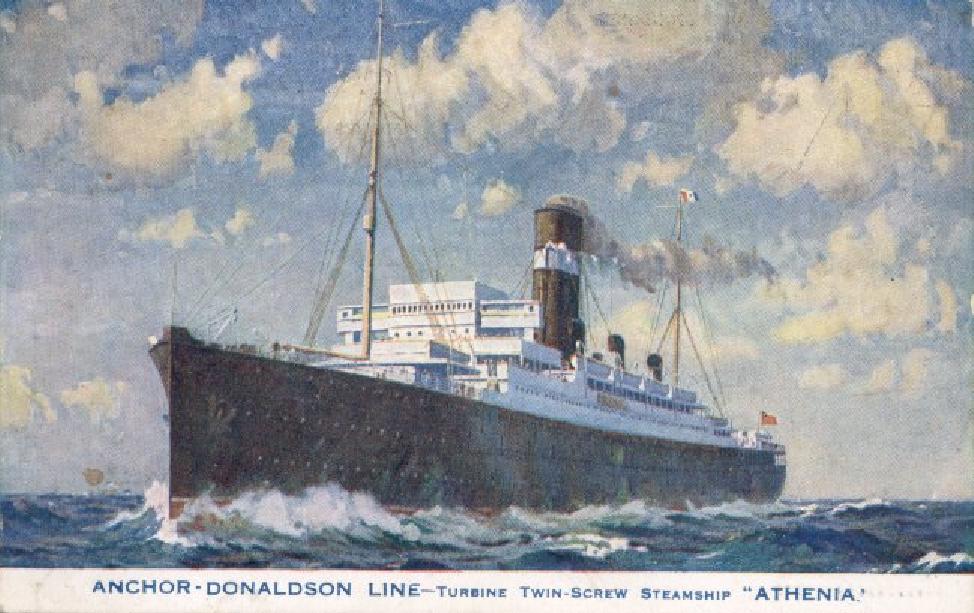 |
When the first British reports were received the German government did not believe them. The Propaganda Ministry asked if the Kreigsmarine was responsible and was told by naval authorities that no U-Boats were in the area. On September 7th, Grand Admiral Raeder stated that all U-Boats had been contacted and none was responsible for the disaster. This was also conveyed to the American ambassador. This statement was not entirely true, for several boats had not reported in. In fact, the Germans would not learn the facts until September 27 when the U-30 returned to Kiel Harbour. |
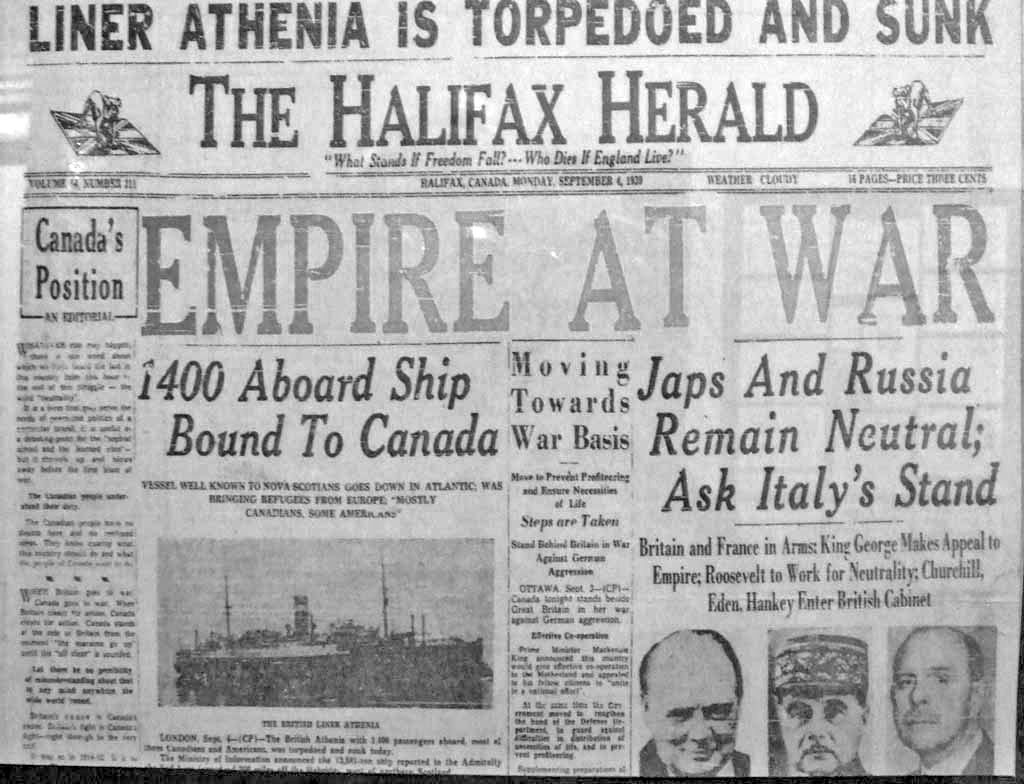 |
|
| The significance was not lost on Hitler. The first thing was to deny everything. According to Josef Goebbels, the Nazi Minister of Propaganda, it was in fact a torpedo from a British submarine that had hit the Athenia. Later he added that it was all a dirty trick by Winston Churchill to discredit Germany and to pull the United States into the war. Hitler was furious and imposed severe restrictions on all U-Boat operations. Admiral Doenitz, commander of the U-Boat arm, was to be frustrated by these restrictions for many months. |
The next step which Hitler undertook was to send out an immediate order to the Kriegsmarine: “The Fuhrer has forbidden attacks on passenger ships sailing independently or in convoy”. |
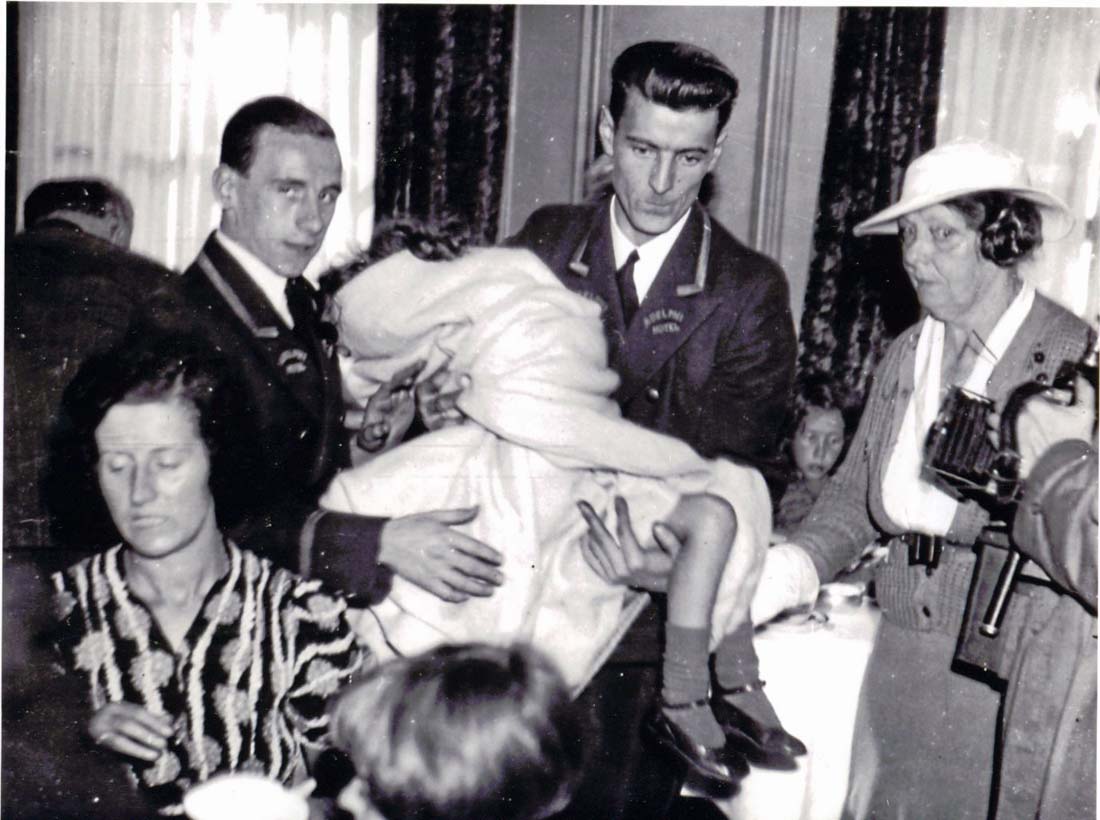 This image, sent to me by Gary Wallace, on 8th July 2011, shows his father, Alexander Adam Wallace, head porter at the Glasgow Adelphi, helping with the survivors of the Athenia. IKt was taken on the morning after, the 4th September 1939, and Gary tells me that many hotels in Glasgow took in these people until the authorities could get passage arranged. |
|
| No amount of official denials could convince the outside world that the loss of the SS Athenia was anything but a return to "German barbarism", as the unrestricted submarine warfare of the First World War had been termed. Such moral limitations on submarine operations were not entirely logical. For a submarine, stealth is its most effective weapon. The Hague Convention agreements requiring submarines to surface and warn surface vessels, allowing crews to launch boats before attacking, were unrealistic. The British reaction was to immediately implement the convoy system and ordered all shipping to comply. | When the U-30 returned to Kiel, Lemp and his crew were given strict orders and sworn to absolute secrecy. They were not to mention anything at all to do with the incident at any time. But the U-30 had arrived in post with victory pennants displayed on her conning tower, one of which showed 14000 tons, the tonnage of the Athenia. The official U Boat Command War Diary makes no mention of the incident and Lemp was ordered to falsify his War Diary by rewriting two complete pages. An entry for any vessel of 14000 tons does not appear. |
|
Web site 3, listed below states that: “Battle of the Atlantic – The six year long battle starts on the 3rd September with the sinking of the liner Athenia by U-30 (Lt Lemp) northwest of Ireland. She was mistaken for an armed merchant cruiser, and her destruction leads the Admiralty to believe unrestricted submarine warfare has been launched. Full convoy plans are put into operation, but in fact Hitler has ordered the U Boats to adhere to international law and after the Athenia incident, tightens controls for a while” Thus began the Battle of the Atlantic. Athenia’s sister ship Letitia did in fact later serve as an Armed Merchant Cruiser but was later converted back and eventually ended the war as a Hospital Ship. This is the names of the 19 crewmembers lost from the Athenia sinking. The first 18 are on the Tower Hill Memorial. The last one is Canadian and is commemorated in Halifax Nova, Scotia. CARLIN , Assistant Steward, JAMES, S.S. Athenia (Glasgow). Merchant Navy. 3rd - 4th September 1939. Age 56. Panel 12. DONNELLY , Assistant Steward, IAN, S.S. Athenia (Glasgow). Merchant Navy. 3rd - 4th September 1939. Age 26. Panel 12. DONNELLY , Assistant Steward, JOHN, S.S. Athenia (Glasgow). Merchant Navy. 3rd - 4th September 1939. Age 23. Panel 12. ELDER , Donkeyman, JAMES, S.S. Athenia (Glasgow). Merchant Navy. 3rd - 4th September 1939. Age 45. Husband of Mary Elder, of Cambuslang, Lanarkshire. Panel 12. FORDYCE , Watchman, CHARLES, S.S. Athenia (Glasgow). Merchant Navy. 3rd - 4th September 1939. Age 65. Son of George and Jessie Fordyce; husband of Mary Penelope Fordyce. Panel 12. GALLAGHER , Greaser, HUGH, S.S. Athenia (Glasgow). Merchant Navy. 3rd - 4th September 1939. Age 23. Son of Thomas Gallagher, and of Isabel Gallagher, of Glasgow. Panel 12. HARROWER , Stewardess, ALISON, S.S. Athenia (Glasgow). Merchant Navy. 3rd - 4th September 1939. Age 41. Daughter of William and Hannah Foster Denny Harrower. Panel 12. HOGG , Assistant Steward, JOHN, S.S. Athenia (Glasgow). Merchant Navy. 3rd - 4th September 1939. Age 51. Husband of Sarah A. Hogg, of Brantford, Ontario, Canada. Panel 12. JOHNSTON , Stewardess, MARGARET, S.S. Athenia (Glasgow). Merchant Navy. 3rd - 4th September 1939. Age 41. Daughter of James and Christina Johnston, of Glasgow. Panel 12. KENT , Assistant Steward, JOHN, S.S. Athenia (Glasgow). Merchant Navy. 3rd - 4th September 1939. Age 50. Husband of Jessie Darroch Kent, of Bridgeton, Glasgow. Panel 12. LAWLER , Stewardess, JESSIE, S.S. Athenia (Glasgow). Merchant Navy. 3rd - 4th September 1939. Age 60. Wife of Patrick Lawler, of Sholing, Southampton. Panel 12. MARSHALL , Bellboy, JAMES, S.S. Athenia (Glasgow). Merchant Navy. 3rd - 4th September 1939. Age 15. Panel 12. *see emails below MORRISON , Steward, DAVID, S.S. Athenia (Glasgow). Merchant Navy. 3rd - 4th September 1939. Age 32. Panel 12. McDERMOTT , Assistant Steward, MICHAEL J., S.S. Athenia (Glasgow). Merchant Navy. 3rd - 4th September 1939. Age 33. Panel 12. McJARROW , Printer, JOHN, S.S. Athenia (Glasgow). Merchant Navy. 3rd - 4th September 1939. Age 39. Panel 12. McKEOWN , Steward, JOHN, S.S. Athenia (Glasgow). Merchant Navy. 3rd - 4th September 1939. Age 47. Husband of M. E. McKeown, of Dunoon, Argyllshire. Panel 12. PROVAN, Barber, DAVID, S.S. Athenia (Glasgow). Merchant Navy. 3rd - 4th September 1939. Age 65. Son of Alec and Margaret Provan; husband of Martha Provan, of Glasgow. Panel 12. THOMSON , Assistant Steward, SAMUEL, S.S. Athenia (Glasgow). Merchant Navy. 3rd - 4th September 1939. Age 45. Husband of Julia McCafferty Thomson. of Glasgow. Panel 12. BAIRD , Stewardess, HANNAH S.S. Athenia (Glasgow). Merchant Navy. 3rd - 4th September 1939 Canadian Merchant Navy HALIFAX MEMORIAL Nova Scotia, Canada Panel 17. http://www.vac-acc.gc.ca/general/sub.cfm?source=collections/virtualmem/Detail&casualty=2557406 Registers and Indexes of Birth, Marriages & Deaths of Passengers & Seamen at Sea. The records are held in what is known as BT files and are very important you remember the file No. The file you need to access is "BT334" This will give you the following information: Name of ship, official No. port of registry, date of death, place of death, name of deceased, sex, age, rating/rank, nationality and birthplace, last place of abode, cause of death and remarks. Outward Bound Passenger Lists 1890-1960 are held in BT27 an gives information on passenger lists of people leaving the United Kingdom by sea kept by the Board of Trade's Commercial and Statistical Department and its successors. There is also BT32 covering 1906-1951 Registers of passenger lists kept by the Board of Trade's Commercial, Labour and Statistical Department and its successors. Please note the PRO will not search their files for you, if you are unable to attend in person, they will give the names of independent researchers who will do it for an hourly fee (very expensive). Public Records Office, |
|
AtheniaLiner (1f/2m). L/B: 526.3 bp × 66.4 (160.4m × 20.2m). Tons: 13,465 grt. Hull: steel. Comp.: cabin 516; 3rd 1,000. Mach.: steam turbines, 2 screws; 15 kts. Built: Fairfield Shipbuilding & Engineering Co., Ltd., Govan, Scotland; 1923. Athenia was built for the Anchor-Donaldson Limited's service between Britain and Canada, and for most of her career sailed between either Glasgow or Liverpool and Quebec and Montreal, with occasional stops at Halifax and St. John. At the height of the winter season she frequently operated as a cruise ship. In 1935, the Anchor Line went out of business, and her owners became the Donaldson Atlantic Line Ltd. Athenia was the first British ship sunk by a German U-boat in World War II. Germany had invaded Poland on September 1 and Britain declared war on Germany at 1115 on September 3, Athenia had sailed from Glasgow en route to Montreal with 1,100 passengers embarked, more than 300 of whom were American citizens. |
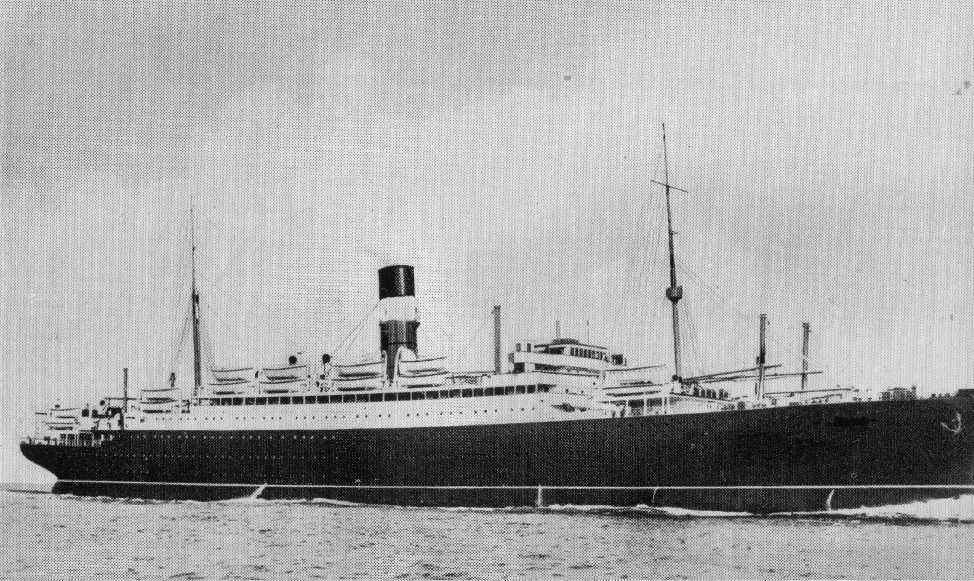 |
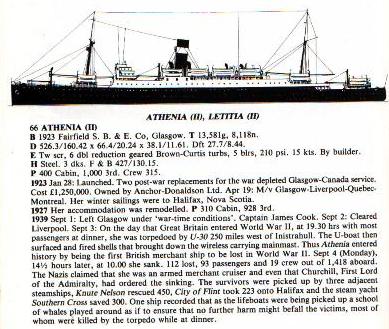 |
|
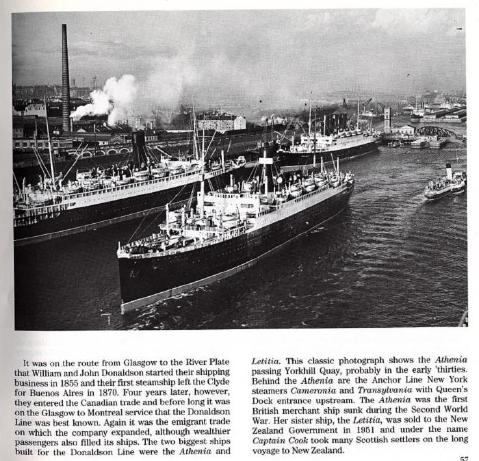 |
|
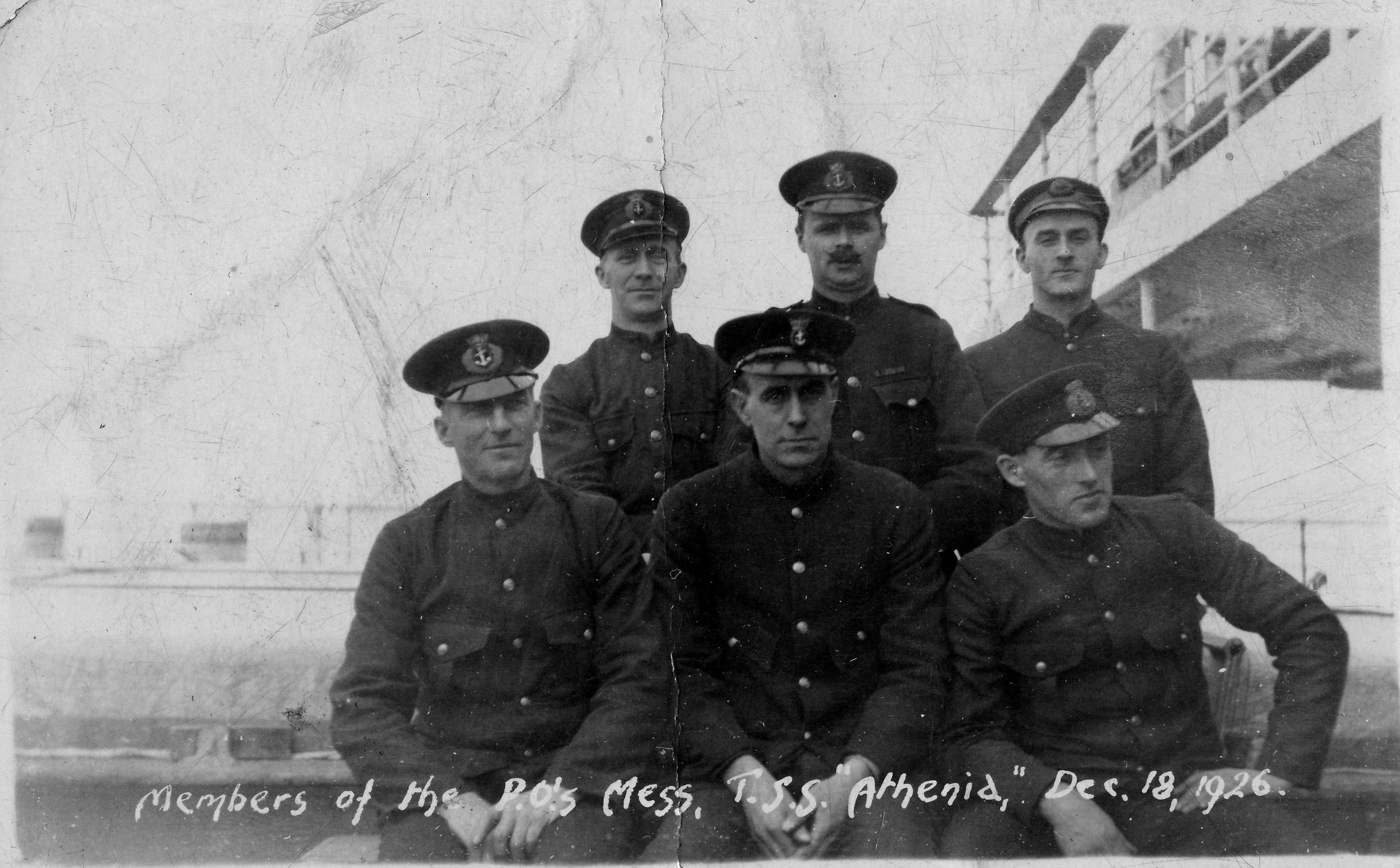 |
|
 |
Text and drawing by Robert Pritchard, survivor. What he means by survivor of death 13 times I have no idea? However the gent in question appears to have been a bit of a braggard and the narrative relating to cheating death 13 times is probably spurious but he DID survive the Athenia. |
|
In July 2012 I received the following clipping was sent to me by William Shatzer, from Portland Oregon. It arrived with a copy of a book owned by Bill's mother and Robert Newton Pritchard had written a pencilled message in the blank page at the beginning of the book and is photo scanned below this claim. The book is called College Zoology, by RK Hegner which is a 1937 4th edition from Macmillan Company New York. However, the following page says 1936. Pritchard is listed in the survivors above as Robert Pritchard, US tourist.
|
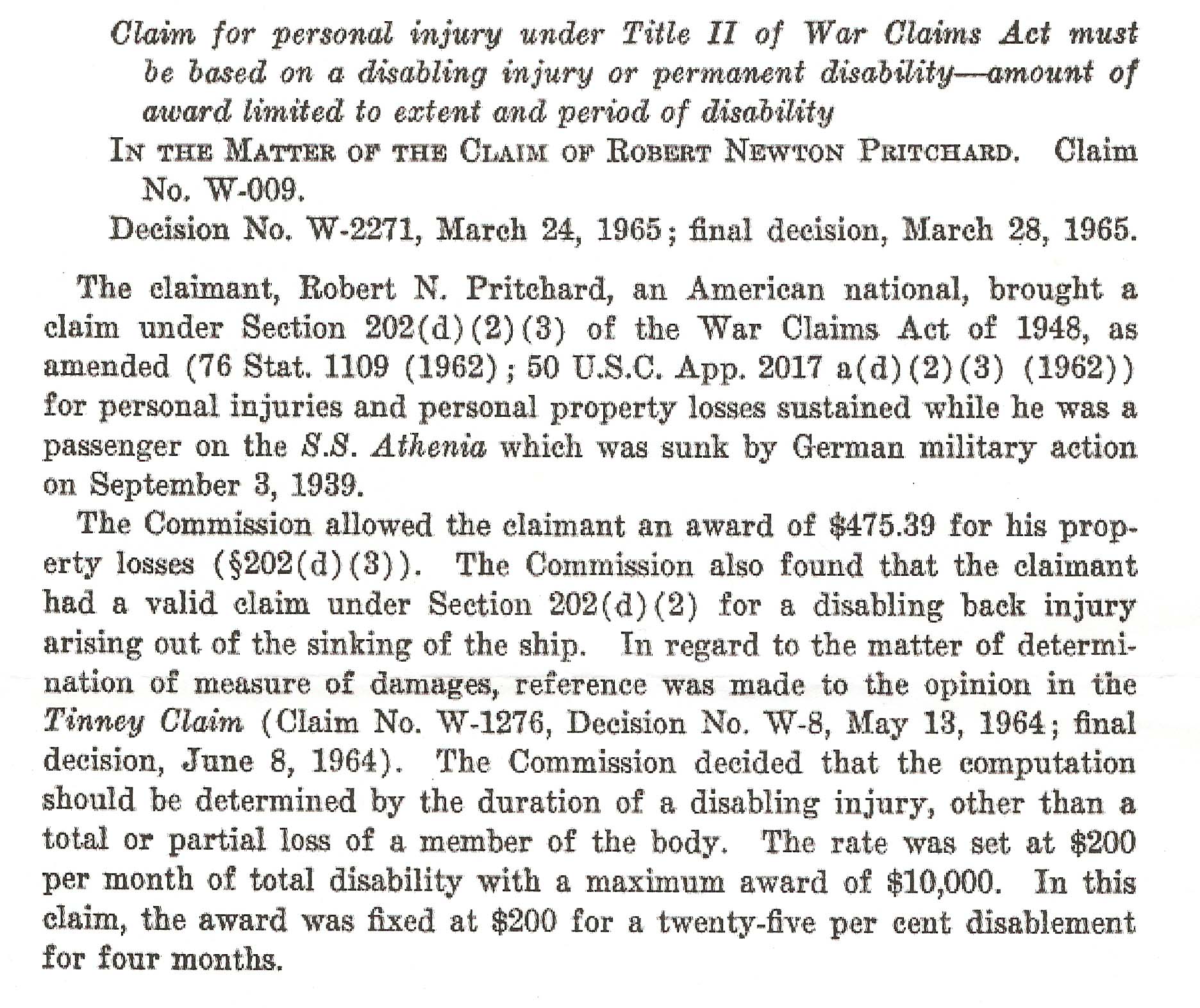 |
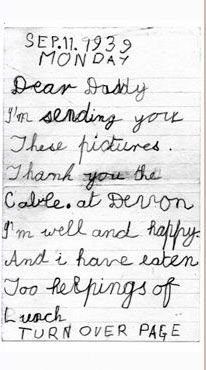 |
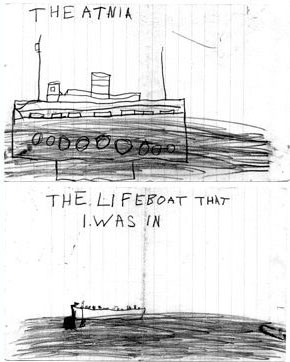 |
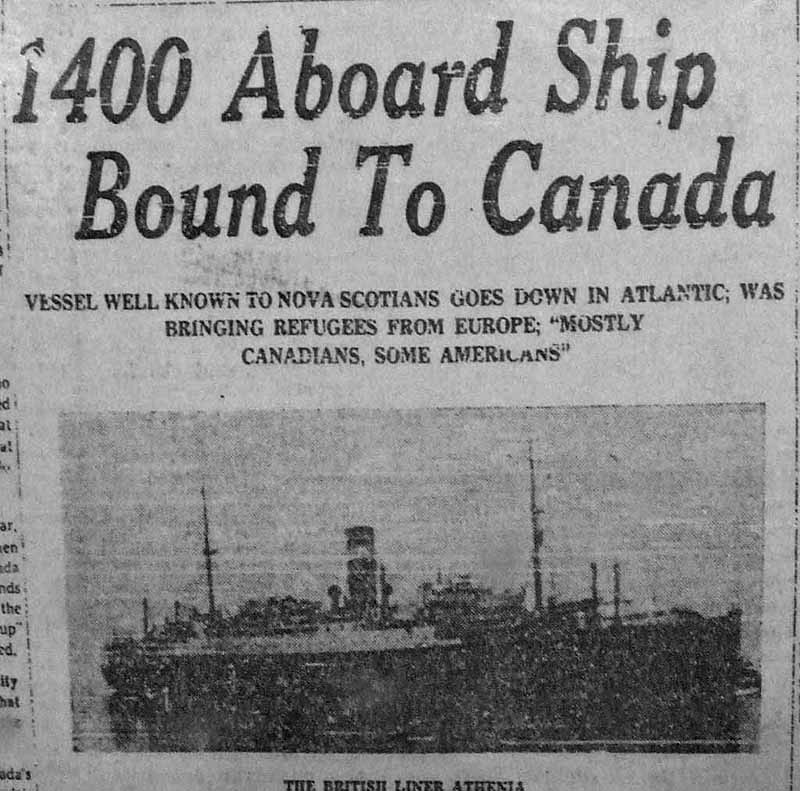 |
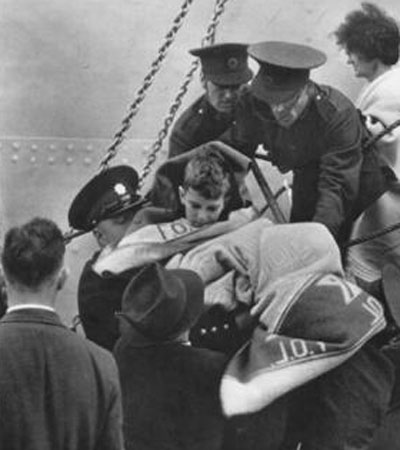 |
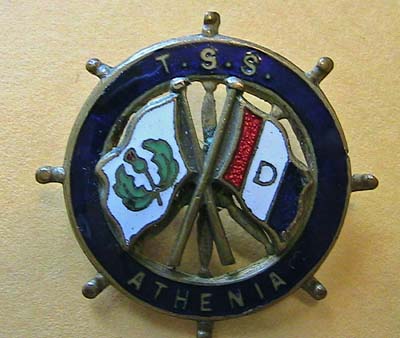 |
|
|
Athenia - A Survivors Story -
Exclusive to my Site
My name is Lona-Marie Attfield and I'm a
survivor! I received a copy from Richard Manning of Life Magazine dated 18th September 1939. This is how it reported the sinking. Below is a composite of a two page representation
Dusk had darkened the North Atlantic on the first day of the second world
War. The British liner Athenia, bound out of Glasgow, Liverpool and
Belfast for Montreal, steamed over uneasy Waters 250 miles West of
Inishtrahull Island off the rocky Irish coast. Of her 1,418 passengers
(75% women and children, 21% American), some were abed seasick, many
were at tables in the dining rooms. At 7:45 pm a shattering explosion
rent the Athenia's steel hull. A waterspout leapt 70 ft. into the air
and cascaded over superstructure and lifeboats. Promenading passengers
were hurled over the rails into the sea. Water surged into the engine
rooms.
My thanks to MacKenzie Gregory for the above Athenia Lists. His site is here: http://ahoy.tk-jk.net/
An Account from BBC People at War - reprinted with family permission On Sunday 3rd September 1939, within a few hours of war being declared the Donaldson Liner Athenia, bound for Montreal with passengers of many nationalities who had boarded at Glasgow, Belfast and Liverpool, was torpedoed by German submarine U30 about 200 miles into the Atlantic. She was the first target, and many of those on board the first casualties, of World War II. I personally was not involved when the Athenia was torpedoed as I was only six years old but it is a time I have never forgotten as my father, Jimmy Mitchell, was the Athenia's carpenter. Thankfully he was one of the survivors. My mother and I spent several frantic days checking survivor lists at Donaldson's Offices, hotels and shops where lists were displayed. Ninety three passengers including 69 women and 16 children were killed in the explosion and in accidents when lifeboats capsized, along with 19 of the Athenia crew. With 1101 passengers and 315 crew on board it was a miracle that so many survived. This was due entirely to the efforts, skills and courage of the crew. Fortunately the Athenia was slow in sinking enabling those trapped below to find alternative means of reaching the boat deck as many of the stairways had been destroyed in the explosion. The slow sinking also played its part in the rescue of a patient from the ship's hospital. It was not realised that she was still there until checks were made on the rescue vessels which had responded quickly. These vessels were the Knute Nelson a Norwegian merchant ship, the Southern Cross from Sweden, the City of Flint from the U.S. and HMS Escort, HMS Electra and HMS Fame. The Southern Cross was a large cruising yacht owned by Swedish manufacturer and millionaire Wenner-Gren. The Athenia's First Officer, whose name I believe was Barney Copland, and two other crew members returned and boarded the stricken vessel and rescued the unconscious woman about 20 minutes before the ship finally sank. The Commander of the submarine, Oberleutnant Fritz-Julius Lemp created panic in the German Naval Command as his actions contravened the Hague Conventions regarding submarines attacking passenger vessels and, amongst other things, they were fearful that Lemp's actions would bring America into war against them as U.S. citizens had been on board. I seem to remember hearing that they even tried to blame a British submarine. The American Ambassador's son John F. Kennedy, a future President, was given the task of checking for U.S. survivors arriving in Glasgow when they arrived there several days after the sinking. By a quirk of fate First Officer Copland and Lemp crossed paths again in 1941 when Lemp was in command of U boat 110. He torpedoed another Donaldson ship the "Esmond" which had been in convoy and had naval escorts. This time all of the Esmond's crew survived including, for the second time, Chief Officer Copland. The U110 was immediately attacked with depth charges by the escorts and forced to surface and Lemp ordered his crew to abandon ship. HMS Aubretia rescued her crew and HMS Bulldog sent a boarding party to the submarine which remained afloat for a considerable time. HMS Broadway was damaged in a collision with the U boat during the action. Amazingly the boarding party was able to remove, amongst other things, an "Enigma" machine together with its invaluable naval codes and instructions which Lemp ordered his operator to leave behind when abandoning ship. Lemp did not survive. He apparently decided not to be rescued when he realised the enormity of his error in allowing the codes to be captured. These had been changed from land based codes upon orders from Admiral Donitz. One might say that Lemp, besides starting the war at sea had, by virtually handing over the "Enigma" and codes to the British Navy, greatly contributed to the defeat of the German Submarine Services and to its navy in general. It surprises me that nothing has ever been made of the "Athenia" affair either on TV or in a film. I do not recall even having heard of any official comment about it although it was brought up at the War Crime Tribunals. (c) Donald Mitchell.
The above medallion was owned by
a Seaman R Williams who sailed on the Athenia.
The above three images were sent
to me by Will Smith - The box containing the paper serviette from the Athenia
April 2018: Adam, sent me the following napkin ring images which has come in to his possession in Australia
In researching a question put to me by a reader of this page I discovered that, in WW1, a ship known as the SS Athenia, was sunk in the same place, with the loss of 15 lives, off Inishtrahull, Eire, by a U Boat in 1917!!! The ship, bearing the same name, was built in 1904. Strange coincidence! September 3rd 2009: I have just been watching a programme on TV commemorating the 3rd September 1939, 70 years on, and the sinking of the Athenia was well documented. The radio operator (see June 2008 email below) was talking and he repeated his claim that they thought it was a 'warship'. He lied on camera by stating that they definitely only fired ONE torpedo when we now know 3 were fired, one misfired and one missed. He also does not admit to the firing of the deck gun, which exploded on the tourist deck, killing and mangling civilians. He has been given a story and is sticking to it. April 07 - An Email: Just read your article with pleasure – my mother Kathleen Ferguson and sisters Kathleen Ferguson (aged 9) and Margaret (almost 3) where on the ill fated ship returning to Canada after visiting family in South Shields. Margaret is still living. I believe there was a photo of her being rescued by a seaman in the Toronto Star (he has her tucked into his life vest). I believe that they were rescued by a destroyer and taken to Glasgow. My mother had a back injury. Her greatest fear in the weeks following were of having to set out again across the Atlantic with two children. My mother said that they never went below deck on the second voyage. It must have been very cold to travel the North Atlantic at the end of October in blackout. My father waited for news of their survival for days and at first only one Kathleen Ferguson was listed because it was thought that there was a duplication. I will be ordering your book. Thanks so much – Gwen Chmilar. April 08: An Email from Australia. My father Eland Sutton was a member of the RNVR; his ship HMS Escort came to the rescue of the Athenia - this is his eye witness story: On September 3 1939 my ship HMS Escort was detached from detail at 2000 hours when the merchant ship Athenia sent out a SOS that it had been torpedoed at 2030 by U-Boat . We arrived at the position before dawn in the darkness, the crew saw hundreds of tiny lights attached to lifebelts of people floating in the water most of these were dead from cold and exposure. Among them was a Polish girl about 12, she was dead, and on her coat was a label showing her to be a refugee on her way to the United States to a new life. Even after many years I often feel upset about that. The survivors were mainly women most of them in night cloths shivering with cold, the crew got spare clothes from been their kitbags and handed them out. Someone asked me "Where is mrs ???? she had a broken leg and had been in the Athenia's hospital"; nobody was sure if she had been picked up. My Lieutenant took a boat across to the sinking ship and found her in the darkened hospital, her first words were "I knew the Navy would not leave me behind". My father passed away in 1982 and was buried at sea by the Royal Australian Navy Volunteer Reserve. My father received a tankard from the MC Donaldson Atlantic line for his part in the rescue; I have only recently donated it to the RSL here in Armadale Western Australia. I believe this tankard is possibly the only one in the world as after sailing my fathers ship was sunk, but fortunately my dad had been sent to another duty! Peter Sutton. June 2008: From John Hewitt, author. One of the survivors of the sinking of the Athenia was a Robert Hanna from Bangor, County Down N. Ireland. I have in front of me a letter which he wrote home to his mother dated 15th September 1939. I am now certain that the U-Boat did fire its deck gun at the Athenia. The bit that may interest you is, He writes, " I was lying munching an apple when a woman screamed,"Look"!. I turned my head and there about 200 yards away sat a submarine, and from it a white streak shooting two towards us. Just then there was a terrific jar, and a loud explosion. The whole boat listed about 45 degrees and I was thrown on deck. I rushed up the sloping deck, because I, like others, thought the ship was going to overturn, it gradually righted, and just then there was a flash, and a "Shell" exploded on the tourist deck, carrying away the mast. Oil and splinters were flying everywhere and one nearly carried my head off as it whizzed by my face. I ran up the tourist companion way and then onto the boat deck. Here everything was a shambles, men and women lying dead all over deck, some terribly mangled". He goes on to say that when he was in the life boat the periscope of the u-boat passed about ten feet from them and the bow caught under his lifeboat almost overturning them. Cheers John. Crew Ransacked First Class Accommodation Instead of Lowering boats! Colleen McCaffrey contacted me in July 2008: My father was a deckhand on the Athenia - he died in 1992 - from Glasgow, Scotland. He suppressed memories of the event during my youth but began to recall the entire event when I found a book about it, Tomorrow Never Came by Caulfield. We traveled to Scotland in 1975 (he had never returned home before that time, though my relatives came to California to visit us) and he proceeded to tell me many of his memories of the event. He was 23 years old at the time and spent hours in a lifeboat with women and children and very little clothing on. He had terrible stories of some of the crew members robbing passenger cabins in first class instead of lowering boats, and the frantic captain trying to organize his helter skelter crew. My father also recounted memories of the sub surfacing in the distance and raking the boat with gunfire. He was picked up by a Norwegian vessel that took the rescued to Canada. At this point, my father told the authorities he was a Canadian citizen and hid out in Toronto until enlisting in the RCAF about one year later. He claimed that Mrs. Lubitch, the wife of the Hollywood director, and her child were in his lifeboat. He is mentioned in the Caulfield book and I have seen a picture of him aboard the rescue ship, wrapped up in a blanket. As a survivor he had a lifetime of guilt about not being able to save more people that night, and himself living while others did not. Aug 11th 2008: I got this email: My family, (my Mother, three siblings, and me - I was nine at the time] and hundreds of others sailed on 2 September 1939 from Southampton on the SS Manhattan hoping to return to America before the bombings began. We had been scheduled to leave on the first but our departure was delayed as the ship was late leaving LeHarve, having to load several thousand folding cots and food for the crowd of passengers desiring to board without reservations. We made an unscheduled stop at Cobb, Ireland to pick up some 200 additional passengers, mostly Catholic priests who had been vacationing there. It was shortly thereafter that our ship received word of the sinking of the Athenia. The Captain, as I remember it, first told us that a man was overboard. We sat dead in the water for many hours while the crew 'searched' for him.. Word did finally filter among the passengers that a German U-boat had sunk a British ship just north of us and that was the reason for the engines being 'stopped'. We became very frightened that we would be their next target. The Captain of Manhattan immediately hung sailors aver the sides of the ship and they spent more than one day painting US flags as large as they could. These flags were bathed in spotlights at night as we got underway. I am sure that sinking affected much more shipping than just ours but thought you might have interest in the ripple effect at the scene. . Jean Knecht Eldredge. August 28th 2008: A film company are hoping to make a documentary regarding the sinking of the Athenia and would like those people who have been kind enough to contact me, to contact them. The email address is as follows: katherine -at - picturefilms.tv. Replace the -at- with @ to send her an email. Sept 8th 2008. An email from Ronal Peers who tells me that his dad, Anthony Peers, was aboard this vessel and was on deck when he recalls the "thud and paint chips flying and ladders falling" but he does not recall the U Boat shelling the ship. He was off watch and was third watch engineer. He also recalls an "orderly evacuation". December 13th 2008: My aunt was a passenger on the Athenia ( a young Greek girl of 24)and she has often told us what happened that day. Today she is 93 and still has her suitcase and all the newspaper clippings from when the passengers arrived in Halifax. I've used your info in a simple family album that I'm putting together. Vasie Kelos, Toronto, Canada. December 22 2008: An email from Greg McCLelland - My Grandfather was the Captain of the Swedish Private yacht, the Southern Cross, that was one of the vessels that came to the rescue of the stricken Athenian. I have the original telegrams received and transmitted from the Southern Cross stating that they had been torpedoed and were sinking fast and they responded stating that they were making maximum speed towards her. The BBC expert stated that these were important historical documents proving that the Athenian had been torpedoed by a U-Boat. You may also be interested to know that the Southern Cross was the largest private yacht in the world at that time, had previously been owned by Howard Hughes, but the owner at the time was Axel Wenner-Gren, the founder and owner of Electrolux. He was friendly with Hermann Goering and, just prior to war breaking out, had tried to mediate between him and Chamberlain to prevent hostilities beginning. Realising that war was inevitable, he left Scotland to visit his friends the Duke and Duchess of Windsor in the Bahamas and it was during this crossing that they came to the rescue of the Athenian’s passengers and crew. My grandfather went on to be a commander in the merchant navy, was sunk two or three times on the Murmansk convoys, but survived the war. The next three images are of the original telegrams regarding Athenia from Greg.
The next two images were scanned and emailed by Allan Marsden
Daily Record - June 10th 2011 Reporter: Brian McIver It was the terrible night when a passenger liner was sunk in flames and entered the annals of wartime naval infamy. But for Heather Watts, who was just short of her third birthday when she was sailing on the doomed passenger ship SS Athenia, all she can remember is having her loving mother wrap her arms around her and refuse to let go. Heather, now 74, is one of the few remaining survivors from the tragedy that caused such international outrage that even Adolf Hitler was too ashamed to admit the truth. The Scot was returning to her family home in Montreal aboard the vessel during World War II when a German U-Boat tracked and sank the civilian passenger vessel, flouting all naval rules of engagement. A total of 117 passengers and crew were lost from the ship's 1103-strong manifest. 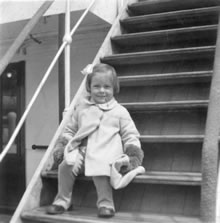 Heather and mother May were among those rescued by a Royal Navy destroyer and taken back to safety in Greenock. The incident has played a central part in Heather's life ever since, and she is making a return journey from her home in Nova Scotia this month to attend the opening of a special exhibit at the new Riverside Museum in Glasgow. She is delighted to offer her unique insight into the high-seas tragedy. And while her own memories are sparse, she taped her late mother's vivid memories and is now able to tell the full story of the catastrophic night of September 3, 1939. Heather said: "It's very special for me to be able to help out the museum and I was pleased to include pictures from the time, as well as my mother's recordings, because it was a very important night in Scottish history, and also for my family. It's something that I have talked about for a long time, and back home in Canada. "I am a local historian and have given talks and contributed to exhibits on its importance and impact for many years. It's nice to do the same in Scotland and I hope people enjoy the exhibit and the story. "One special thing we are able to contribute is that we actually have pictures of us on board the ship, taken on our journey to Scotland, as there were not many taken on the way back and I'm delighted to offer them to the museum." Heather's mum May was from Beauly, Inverness-shire and her father from the Borders but both emigrated separately to Canada, where they met, married and had their daughter. In 1939, May made the journey across the Atlantic on the Athenia to let her meet the relatives in the old country, and after a lengthy visit boarded the same ship again for the seven-day return. The war was now in full flow, and with the family keen to get away from the looming German invasion threat, were delighted to make it on board for the voyage home. 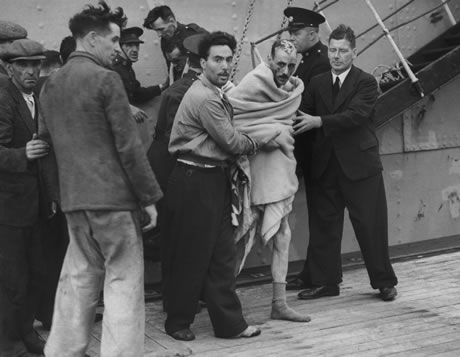 There were strictly agreed maritime principles protecting purely civilian traffic but then, on September 3, at around 7pm, U-30, captained by Fritz Julius Lem, saw an easy target and tracked it for several hours. Then they pounced, piercing the hull with a torpedo, making the Clyde-built vessel the first British ship to be sunk during the war. With the ship listing to the stern, lifeboats were launched. Heather recalled: "It was the second night at sea and after dinner we went back to the cabin and when the torpedo struck." There was an almighty jolt, the lights went out and the ship immediately listed. She went out to the corridor and said she could smell explosives. Heather added: "We were very fortunate because we were in our cabin, which was higher up in the ship and close to a muster station. Others who were closer to the boiler room, where the torpedo had struck, reported water coming in. "My mother was able to grab a lifejacket and a fur coat to keep warm and got us to our station very quickly. "The worst part of this was during the lifeboat launch, because one of the ropes broke, meaning the boat dropped the last seven feet and went right under the water and then came back up again. The rudder had broken off and the hull was damaged. "There was a lot of black oil in the water and we all got covered in it. We were in that boat for 11 hours and had to bail out the entire time. It was mostly full of women and children. "My mother remembers holding me on her knee with one hand and using the other to bail out with her slipper. "My own memories come from the times when I was separated from my mother, mostly during the rescue, and I think that was because even though she was a nervous person, she did an incredible job of making sure I wasn't frightened. "Before the torpedo had struck, she was reading me a bedtime story and when we were in the lifeboat, she made sure to finish the story." 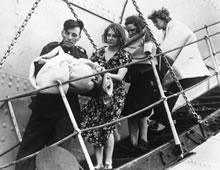 The worldwide reaction was of outrage and horror. Captain Lemp only avoided court martial because Hitler demanded the incident be hushed up for political reasons. The Nazis later claimed the British attacked their own boat but after the war, the German Fleet Admiral admitted the crimes. Heather eventually returned to Canada after an extra two months with her relatives in Beauly. Happily, Heather's second complete voyage was incident-free. She later returned to Scotland several times, including several years working in Edinburgh as a secretary. Now retired, she has three children, Andrew, Alison and David, with husband Derek. When she and her mother returned to Canada, her father, John had already joined the Canadian Black Watch and spent the next five years fighting the Germans who had dared to attack his family. She said: "It is something that has been a part of our lives but I only really realised how big an event it was when I started researching it around 20 years ago. "My mother was amazing, and got me through that night so well. "It was only years later, when I finally decided to find out all about it, that I got her to sit down with a tape recorder and recall the entire story. It's a lovely record of her memories. March 2009: I received an email from Erika Federman nee Hubscher. I just happened to notice your request about survivors of the Athenia. After so many years I am in the process of writing my story. I was a passenger on the ship, rescued by the private Swedish yacht and later transferred to the City of Flint, an American Freighter, to continue to the States...my brother and I became separated from our Mother and came alone first to Halifax and from there we were flown to New York by The Journal American, a New York newspaper...we made all the Movietone news, etc. A German television crew interviewed me and I appear at the onset of their film. I came across your notice while researching some of the facts of the sinking. We were Austrians who were awaiting our visas to the United States in London and those came only a couple of weeks before the start of the war. By the way, I saw that life boat go under because it was just ahead of ours as we pulled up to our rescue ship. I would like to find others who survived...do you have their names or addresses? (sadly , no - mk). * Ref James Marshall. April 9th 2009: From William Gibbins (New Zealand). My Canadian born mother Susan (nee Mooney) and her siblings travelled on the Athenia with their Irish born Parents to Belfast Northern Ireland in November 1937 and they made friends with many of the crew. My mother who was 15 years old at the time was in particular very fond of the Bell Boy looking after her cabin and was saddened to hear of his death when the Athenia was torpedoed. From the crew list you have on your site James Marshall seems to match the recollections of my mother who remembered him fondly and talked a lot about her wartime experiences in Northern Ireland and travel to New Zealand in 1951 on the SS Atlantis. I found this site by accident when looking for some pictures of the Athenia to check against an old photo I have of a ship of similar size found when redoing and album of old photographs from my mother. The photo I have is similar but the ship (taken in the distance) does not match the Athenia. The story my mother heard on the sinking was that the Athenia was targeted because it was claimed she was carrying arms, a claim my mother always vigorously denied saying she had been around every “inch” of that ship and saw no evidence of arms and said the Athenia was only a small ship and there was no place where they could be stored. Your site and others I have found finally tell the truth surrounding the sinking of the Athenia rather then the propaganda my mother heard at the time.
* Ref James Marshall. Reply dated 28 november
2013: I am the archivist for Govan High School in Glasgow. I was
able last year to discover that James Marshall had been a pupil at this
school. This year, a War Memorial commemorating all those included James
was unveiled at the school. Through much searching, I had also been able
to contact some of James’ relatives-two nieces. They both attended, and
have since sent a lovely letter to the school thanking us for ensuring
James is not forgotten here in Govan. May 09 Email from James Birmingham: My wifes late stepfather was a sailor in the Royal Navy aboard HMS Escort. He saved some of the passengers of the Athenia. He was presented with a silver cigarette case, with an inscription:- J Harrison HMS Escort from Athenia Survivors 4-09-39 On Aug 10th 2009 I received this email: My name is Cyril Smith. Last year, my son Kyle Bradford Smith and I, in doing interviews of WW 2 veterans in our community, came across Barbara Wilson. She had been a survivor of the SS Athenia's sinking. Barbara Rodham was 23 years old and summering in England when she booked on Athenia to escape the threatening war clouds. She had not spoken about the incident in many decades and thus her involvement, and indeed, the incident itself was lost to the local population's memory here. We independently verified her account from the New York Times and other sources. We honored her at the last Veterans Day (Armistice Day Nov 11 2008) and recently arranged for her selection as a "Woman of Distinction" by the NY State government, to include the New York State Military Museum. Her story and that of the SS Athenia will be part of the Museum's "They also served" portion of the exhibit. Given the approaching 70th anniversary of the sinking, we are working towards some potential television appearances. For purposes of your website, we can work with you on your interviewing Barbara and/or gaining any information you may seek. She does not do computers but a telephone or personal interview is possible, to include the notes we have from our own talks with her. She has an extensive scrapbook of letters, headlines and some memorabilia from the SS Athenia. Unfortunately, as I told Cyril, I live in the UK, so could not afford such an interesting and illuminating interview. Aug 2009. An email from Clare: We would like to know how many tankards went out to people and the inscription on the one my father owns is as follows: Presented by the Directors Donaldson Atlantic Line Ltd Owners T.S.S Athenia Sunk by enemy submarine 3rd September 1939 The tankard is pewter and the hallmark is ep then an arrow points to the right with the letter ns after it. Can anybody help with any information about these tankards? Aug 31st from Ros Jones: I'm researching my family tree, and had just discovered that two of my grandad's cousins, Graham Hopkinson and his wife Ethel, boarded the Athenia at Liverpool on 2nd September 1939. They were headed for Montreal. I was horrified to discover, on a search for Athenia, that she had been sunk - and so relieved to learn from your site that Graham and Ethel were rescued (by the Knute Nelson).. Graham came from Derby, where he was one of nine surviving children of William Hopkinson (my great-great-uncle) and Eliza née Tagg - both from Nottinghamshire. Graham's elder siblings emigrated to the US or Canada in ones and twos between 1900-1911, his parents and younger siblings leaving as a party in 1912. HIs parents died in Brooklyn in 1913 and 1918. His brother Harry was killed serving with Canadian forces in France in 1918. Graham was the only one who stayed behind in the UK. I'm guessing by 1939 he began to think his brothers and sisters had made the better choice, and made preparations to join them, but wasn't quick enough. September 4th 2009: An email from Michael Curran: My father, Frank Curran told me this - He was a clerk in the Palgrave Murphy shipping office which was the Lloyds and American Consular Agency ,Galway. Appoximately 600 survivors were expected in Galway on Swedish ship MV Knute Nelson under Capt. Carlson. My father's duty was to search the town for baby requisites blankets etc on Sunday morning, knocking up the local traders who mainly lived above the shop. The Irish army and Gardai, Red Cross and the local authority were involved.. When the survivors arrived they were brought ashore on the tender which was used to service the liners that called to that port at that and many had to sleep on straw in the transit shed on the pier, which had been newly-built. Many of the survivors were American and it was very important for their diplomats to find out if any had seen a submarine, as that would be a cause of war. The American survivors were asked to make their statement on oath. As no bible was available in the office the LLoyds Register of Shipping, a large book was used as substitute, showing only the back cover. Some thought they had . My dad took a photo on a windswept MV Knute Nelson of Mr Cuddihy the American minister formally thanking Capt. Carlson. Later, American and Japanese civilians from Europe were repatriated through Galway under Red Cross arrangements. I remember playing with the Japanese children on the ship while it was anchored in Galway Bay. Regards Michael Curran.
The above postcard was copied to me from Isobel Seymour who tells me:
May 2010:
I have a postcard of the Athenia sent from Liverpool (dated 2nd Sept 1939)
to my Great Aunt Jennie from her emigrated cousin Annie Norrish, who had been
over visiting the homeland for a wee holiday. She booked passage to return to
Canada on the Athenia as soon as war looked likely. She did survive, but lost
her arm (I don't know the circumstances).
This was sent to me by Dudley Bradley
Sept 2010. An email from the USA. I was 12 years old in 1939. We had moved so much during the great depression that this was the first September I would return to the same school I had left in June. I was a week late but knew who my homeroom teacher would be -- Mrs. Kelly. I hastened down the corridor but a strange woman stood at the door. When the bell rang for movement to classes I asked my friend Hank what was wrong. He looked at me as if I had missed all the news that week. "Haven't you heard? She was torpedoed by a U-boat trying to get back to North America. She is alive and will be back soon. Actually it was six weeks before we saw her again. She was a good teacher (maths) and I liked her. She had spent a holiday in the UK with her sister but both were saved. Joseph W. Brownell. October 2010: From John Shaw. My Grandfather, John Farrell Shaw was a Steward/hairdresser on the Athenia and survived the sinking. He was commended for saving passengers and received a medal according to my Gran who passed away 1990. The medals were lost a few years after the war, I never got to see them. My Grandfather went on to be torpedoed again on the MV Accra on 26th July 1940 but also survived this. His luck ran out on 29th October 1942 while serving on the MV Abosso which again was torpedoed by U 575 on route from South Africa to Britain. I always wonder if he was one of the people to get off the ship in one of 5 lifeboats only to be lost later - only one lifeboat was rescued. His name is on the Towerhill Memorial and even though he died when my Father was only 18months old I am very proud and grateful to him. His generation were definitely a breed apart, showing courage and steel that generations since have not had to - perhaps due to their sacrifice. May 2013: I'm the archivist of Govan High School in Glasgow and thought you might be interested to know that James Marshall, bellboy on the "Athenia" was a former pupil of this school. We have commemorated him on a timeline of the school's history and also on a newly commissioned war Memorial. It was nice to read on your website that he was remembered fondly by the mother of one of your correspondents. That is the first connection we have been able to make to what kind of person he was before he was killed so tragically young, so this is really just to thank you for publishing it. Best wishes Ian Ian McCracken Archivist Govan High School Glasgow
latitude:48°30'0''N longitude:028°50'0''W wreck position.
|
Referrals:
I got the above information from many sources, some more accurate than others. Some can be wildly inaccurate such as a Liverpool Museum site that states that the U-110 sank the Athenia. NOT, I might add, the one listed below. However, the main sites that I can recommend are:
1. http://www.greatships.net/athenia.html - articles on Athenia
2. http://uboat.net/history/athenia.html - Excellent U boat site – Athenia
3. http://www.naval-history.net – Day by Day, Month by Month, the story unfolds.
The photograph of the Halifax Herald is on display in HQ Western Approaches, Rumford Street, Liverpool that has its own web site at:
4. http://www.liverpoolwarmuseum.co.uk
5. http://smmlonline.com/articles/athenia/athenia.html - Modelling site
6. http://www.onthenet.com.au/~biss/athenia.htm - Informative
7. http://www.theshipslist.com/ships/lines/donaldson.html - Shipping company site
The following information can be found on another Athenia related site at: http://ahoy.tk-jk.net/macslog/SSAtheniaFirstCasualtyoft.html the site of Mackenzie J Gregory.
http://www.gjenvick.com/DonaldsonAtlanticLine/1938-09-02-PassengerList-WB-Athenia-Cabin-Tourist.html
http://www.ahoy.tk-jk.net/macslog/LetterofthanksfromanAthen.html copy of a letter from a passenger on the Athenia.
http://www.telegraph.co.uk/news/newstopics/world-war-2/6163696/World-War-2-Torpedoing-of-Athenia.html 2009 reprint of the news
![]()
Maritime Disasters of WW2. My first
ever book - order it here - please? £11 only - click on the banner
Buy My WW2 Book here - Athenia is Chapter One
http://www.orcadian.co.uk/features/articles/athenia.htm
January 2006: The Orcadian, an Orkneys Newspaper, has published an article on the Athenia, in particular, a lifeboat of hers. Click on the link above to view the article.
http://college.hmco.com/history/readerscomp/ships/html/sh_008100_athenia.htm
|
To Merchant Navy |
|
To WW2 Sea Index |